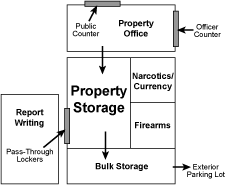- 01: Introduction
- 02: History
- 03: Propellants, Firearms, and Ammunition Development
- 04: Modern Firearms Manufacture
- 05: Small Arms Ammunition
- 06: Evidence Handling Procedures
- Introduction
- Objectives
- AFTE Knowledge and Ability Factors
- Types of Evidence
- Associative Evidence
- The Crime Scene
- Evidence Submission
- Laboratory Evidence Handling
- Case Tracking Within the Laboratory
- Firearm and Toolmark Examination Considerations
- Selected Bibliography
- 07: Equipment and Instrumentation
- 08: Examination of Firearms
- 09: Cartridge and Shotshell Examination
- 10: Characterization and Evaluation of Fired Projectiles
- 11: Bullet Comparison and Identification
- 12: Gunshot Residue and Distance Determination
- 13: Toolmark Identification
- 14: Communicating Results
- Resources


Storage Options
Home > Evidence Handling Procedures > Case Tracking Within the Laboratory > Storage Options

Laboratory layout with centrally stored evidence
How evidence is secured in a laboratory is based on the physical plant and the organizational structure of the laboratory.
Physical plant factors include
- overall size of the laboratory building,
- amount of space allocated for storage,
- whether the building was originally designed or retrofitted as a laboratory.
Organizational structure factors include
- number of disciplines performed in the laboratory,
- staffing level of the laboratory,
- the number of disciplines performed by individual examiners.
Storage of evidence for each forensic discipline or groups of disciplines is handled in either a centralized or decentralized system. Centrally stored evidence is checked out and in by the examiner as needed. In comparison, a decentralized system allows for more immediate access to evidence because it is stored in the examination area.




